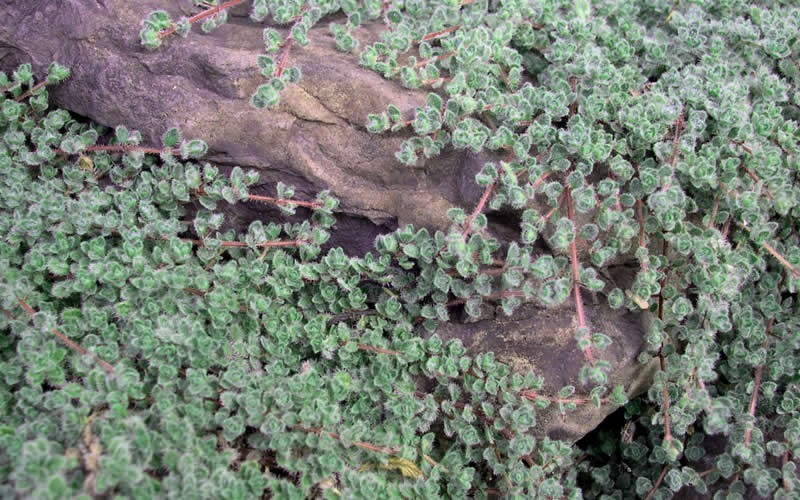

Pale pink flowers dot the carpet of leaves in.

WOOLLY THYME THYMUS PSEUDOLANUGINOSUS FULL
It grows well in dry well-drained soils in the full sun. Very prostrate evergreen with hairy stems and silvery-green woolly leaves which form a dense aromatic carpet. It is often grown as a groundcover, where it can form extensive low mats. Wooly thyme is a very short prostrate herb in the Lamiaceae (mint) family from Europe.

Thymus pseudolanuginosus is cultivated as an ornamental plant. Both growth low to the ground and leaf hairiness could be an adaptation to a cold or snowy climate, for example a mountainous habitat. The leaves in wild creeping thyme vary from slightly glabrous (smooth) to sparsely covered in white hairs, or thickly covered on both surfaces, with the margins ciliate (hairy), or just ciliate at the base. Thymus pseudolanuginosus - commonly called woolly thyme - is now also classified as Thymus praecox subsp. It is of unknown specific origin in southern Europe. This low-growing creeping thyme with hairy or woolly leaves and stems, can be quite difficult to delineate between other hairy and non-hairy creeping thymes. It was also formerly known as Thymus lanuginosus. Thymus pseudolanuginosus - commonly called woolly thyme - is now also classified as Thymus praecox subsp. It also spills gracefully over stone walls and boulders and can be grown in container gardens as a soil cover. A strong grower, with the right condions it is ideal as a drought-tolerant lawn substitute. It is also ideal for planting between the gaps of stepping or paving stones, tolerating moderate foot traffic. Patios, walks, rock gardens, stone walls, and pond borders all benefit from the creeping, cascading habit of Woolly Thyme. Ensure the soil is well-drained.įorming a dense mat, Woolly Thyme makes an excellent selection as a groundcover on dry slopes or embankments or in garden beds. Its been claimed to be everything from a trance-inducing drug to an aphrodisiac. Romans loved the fragrance and planted it all over Europe. In summer, tiny pink tubular flowers appear. Thyme is one of the most historic plants on earth. The foliage has barely any fragrance and is unsuitable for culinary use. Constantly wet or soggy, overwatered soils will cause the plant to rot. Woolly thyme Thymus pseudolanuginosus TY-mus soo-doe-lan-oo-gan-OH-sus Audio Woolly thymethe wooliest of all thymesforms a dense ground-covering mat of tiny, densely hairy leaves. The densely haired, tiny, fuzzy grey leaves on creeping stems form low, dense mats of ground-hugging foliage that grows to about 1 inch in height with a spread of 12 inches or more. In summer, pretty, tiny, tubular, soft-pink flowers contrast nicely with the foliage.Įasy to grow, Woolly time prefers a well-drained, average to poor soil and full sun. Though the foliage has little to no fragrance, and thee is no culinary use, it makes up for it with some of the most attractive foliage and flowers of any thyme. In botanical terms, the Woolly Thyme belongs to the Lamiaceae family, the genus Thymus and the species Pseudolanuginosus, hence its scientific (or botanical) name Thymus Pseudolanuginosus. Pale pink flowers are borne in early summer, however, Woolly Thyme is not as floriferous as the other. The foliage may take pink tones in cold winters. A creeping, mat-forming subshrub, 5-10cm tall, with small dark green leaves, up to 8mm long and 4mm wide, usually fringed with minute hairs. There are plants you just want to touch, and a woolly thyme plant (Thymus pseudolanuginosus) is one of them. One from our 'Toe Tickler' collection, Woolly Thyme is one of the best of the evergreen thymes. Primarily used as a ground cover, Thymus pseudolanuginosus (Woolly Thyme) is a creeping, mat-forming sub-shrub forming a dense cushion of small, dark green leaves usually covered with long hairs.


 0 kommentar(er)
0 kommentar(er)
